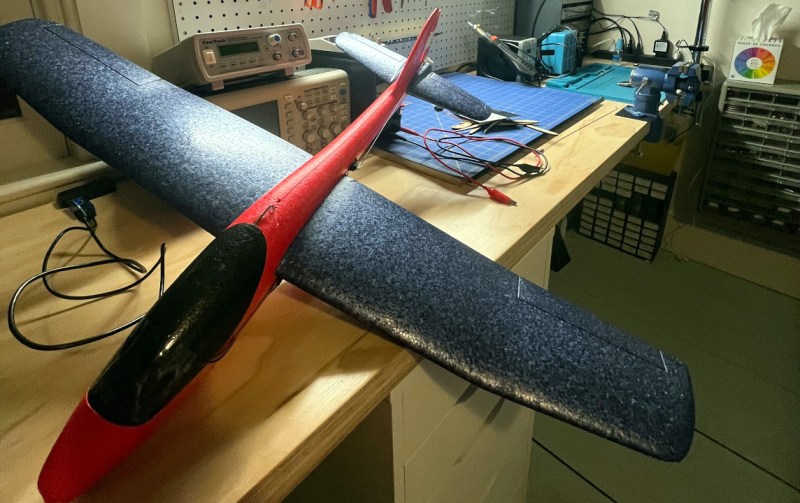As the technology available to the average hacker and maker gets better and cheaper each year, projects which at one time might have only been within the reach of government agencies are inching closer to our grasp. Take for example the impressive work [Charlie Nicholson] has put into his StratoSoar series of autonomous gliders.
Dropped from several thousand feet by a high-altitude balloon, the glider’s avionics are designed to either guide it along a series of waypoints or head directly towards a specific target. Once at the given coordinates it can initiate different landing programs, such as spiraling down to the ground or releasing an onboard parachute. It’s an ambitious combination of custom hardware and software, made all the more impressive by the fact that it’s been put together by somebody who’s not yet old enough to have a driver’s license.
 [Charlie] originally experimented with developing his own airframe using 3D printed components, but at least for now, found that a commercial off-the-shelf foam glider was a more practical option. All that’s required is to hollow out some areas to mount the servos, battery, and the avionics. This takes the form of a custom PCB that contains a ATSAMD21G18 microcontroller, an ICM-20948 inertial measurement unit (IMU), connections for GPS and LoRa modules, as well as several onboard sensors and some flash storage to hold collected data.
[Charlie] originally experimented with developing his own airframe using 3D printed components, but at least for now, found that a commercial off-the-shelf foam glider was a more practical option. All that’s required is to hollow out some areas to mount the servos, battery, and the avionics. This takes the form of a custom PCB that contains a ATSAMD21G18 microcontroller, an ICM-20948 inertial measurement unit (IMU), connections for GPS and LoRa modules, as well as several onboard sensors and some flash storage to hold collected data.
The goal of this open source project is to make these sort of unmanned aerial vehicles (UAVs) cheaper and more accessible for hobbyists and researchers. Eventually [Charlie] hopes to offer kits which will allow individuals to build and operate their own StratoSoar, making it even easier to get started. He’s currently working on the next iteration of the project that he’s calling StratoSoar MK3, but it hasn’t had a flight test yet.
We’ve seen various attempts to launch autonomous gliders from balloons in the past, but none from anyone as young as [Charlie]. We’re eager to see the StratoSoar project develop, and wish him luck in future test flights.
















Extremely impressive. The creator is a child! I was wrestling in the mud with the other kids at that age
Exactly, it’s exactly that thought that made me smile. Pretty cool stuff to do at 14, the internet (shared knowledge, cool free tools) and dirt cheap electronics stuff from countries far away all allowed for this.
Sometimes I think I was born 4 decades to early…
I often had the opposite thought, that I was born 2 decades too late: In the beginning of the internet everything was much more “hands on”, more adventurous discovery-ish, modding modems, hacking phone companies for free internet and only friendly nerds online. Such a fun time in my imagination :) Now its not only mainstream, its also too big to understand.
I guess one can always complain that it would be so much better to be living (growing up) then instead of now ;) Also, I am quite happy that there were no smartphones yet when I grew up…
He’s surely very talented, I think.
Avionics isn’t exactly easy, he had to work carefully here.
So this young experimenter deserves all the respect, I think.
But playing in the mud at age 14, really?
Hm. I remember stsrting programming in Visual Basic and QuickBasic at age 7 in the 90s.
On an old, used second-hand 12 MHz PC running DOS and Windows 3.
Before this, when I was in pre-school, I had a Sharp MZ computer with datasette.
But playing in the sandpit/mud? Are you boomer generation, by any chance? Or was this just a joke?
Because kids from Generation X usually grew up with things like C64 or construction sets or so I heard.
You know, building crystal radio sets, morse buzzers, alarm systems..
Toying with electronics and other technical things. Chemistry sets, optical kits, metal construction sets and so on.
Kids back in the 1970s, 80s and (partially the 90s) tinkered with such things from age 8 onwards.
I don’t mean this as an offense, really. I’m honestly surprised.
An acquaintance from former east Germany had told be that he played in sandpit age 12-14.
Since thst person is a boomer, that must have been in the 1970s.
Hearing this was such a shock to me, to be honest.
At first I thought he was disabled or something.
Because I’ve always thought it was normal for kids about age 8 and up to be reasonable and tech savvy.
In the 80s, I read in magazines, some kids that age did program their own little games on C64 already.
Always made me feel a bit uneaesy about my own programming skills.
(Btw, in the 1950s and 1960s, didn’t 8-11 years old often build crystal radios, too?)
At this age (14), in Germany (former W. Germany) you’re in secondary school already, learning about geometry in math and have English class.
You also have things like sex. ed. in biology class already (in class 5/6 students are roughly 11-12).
Sure you do make childish nonsense, still and play outside.
But you’re almost considering youself an adult by then.
That’s the age you slowly start to think that your teachers and parents lack a certain maturity, too. ;)
It was indeed a joke. I only played in the sandbox until I was 11!
At age 14 I was programming in visual basic and C, writing web servers, chat programs and a lot, lot more. I rigged together a TTS and STT system to have a poor kid’s voice assistant
I also fondly remember hosting my brother’s wedding photos on a spare laptop at home (good old days before CGNAT). I made a security system using a serial GSM modem which was actually used for a few months.
I also tried making some games with a now forgotten (I think?) javascript library called enchant.js. All very fun activities.
Still everything I did was across different domains and stuff, it was definitely nothing as sophisticated and long running as this kid’s achievements.
Haha. I see, thanks for clarifying! 😅
You did very well, btw. At age 16 you could have had your own company.
https://tinyurl.com/b67d2yez
Did all that and yet still played in the mud and still do.
This guy is doing the same thing, getting some really EPIC footage along the way: https://www.youtube.com/watch?v=7Cl4hynKw0w
Don’t want to be that guy, but here’s the original from 20 years ago. Not Open Source, however.
https://www.gpsboomerang.com/content/view/34/42/
Hi! Yeah, I saw this. One of the goals of my project is to make it fully open source and low cost.
I think rctesrflight did the same? Or was it the rcexplorer? Cannot remember.
The problem with being “that guy” is recognizing that every activity or invention under the sun stands on what came before it, and remembering that in order to surpass what came before, one must first match what came before.
Simply because something was already done, does not take away from doing it again. To get a complex project like this to even match the state of others doing similar work takes a lot of time, effort, skill building and knowledge gathering.
The kid is not claiming “first” or anything like that (which would warrant a correction). We all know others have been doing similar stuff all over the world for decades. You aren’t really adding to the conversation by pointing it out.
Besides, as the article opens, technology improves. “Recreating” an older project with modern technology and easier to obtain OTS parts DOES contribute to shortcut a lot of work by anyone else wishing to do a similar project. Yet, still requires a lot of trial and error to get it right.
Not to mention there is a high level of custom PCB work, coding, component modification and post data analysis that was done.
Finally, all of this illustrates the builder’s ability to manage a complex project, gather resources and stick to it through difficult failures.
If you had made a post with the intent of making the builder aware of some prior research they should add to their collection, or found a solution in that research which could be helpful to the kid, that would have been far more constructive.
A better way would have been to ask “have you seen this/these projects? If so, what did you take away from them to help you in your project? What did you choose to do differently and why?”
Last time this came up: https://hackaday.com/2013/03/10/launching-a-glider-from-space/
We also linked a similar project from 2001.
What about 120m air traffic rules?
Or flying fully autonomous aeroplane on top of urban areas..
i keep copious lab notes and, on inspecting them, my overall impression is that it’s easier to apologize than to ask permission :)
Hope you don’t hit something, you’ll need more than lab notes.
You’d be more likely to cause harm by turning left on a daily commute than by dropping a draggy, <250g glider.
Hey! I got FAA clearance and filed a notam to do this launch.
The number of fields of knowledge named in the video is too damn high.
Thanks!
RIP Les Haines and ElReg’s SPB
https://www.theregister.com/2011/07/01/spb_launch/
https://www.theregister.com/2016/12/27/the_life_and_times_of_lester_haines/
Could such a glider take pictures ? eg a very short exposure time to recognize a UFO.
Yep! Working on that for MK3.
Hi Charlie!
It would be very welcome to attach some pressure/humidity/temperature sensors and to log the data. You can compare the results with the aerosonde measurements, and it will probably be relible for some scientific applications. Good luck. Petr, PhD.
I did that on my most recent flight!
The short wing span hurts efficiently and resilience to strong winds.. The project will eventually make use of solar and kg:wH to be useful
Really impressive project overall, both from a technical, and also just from a project management perspective. More than a lot of university students would be able to pull off by themselves.
Regarding the legality, I had a short twitter thread with Yohan Hadji: https://twitter.com/Marian__Keller/status/1820188890705117355
Let’s just say that in my impression, It seems like at least the Swiss Federal office of Civil aviation, and in extension, EASA, seem to be aware of such activities and still treat the whole system as an unmanned free balloon, see SERA Appendix 2.
Good lord the comments. “Looks like a cheap toy” what cheap toy has you designing your own circuits and programs? Did you folks not read that he was 14? When I was 14 I was messing around with Lego Mindstorms robots and some simple BASIC programming but my eyes glazed over looking at C++ or anything to do with circuits, forget PCB design. Kid has done some really impressive experimentation here. Including abandoning the whole process of building the glider when faced with evidence that store bought was easier. How many people would give up at that point from all the lost time/wasted effort? Charlie you’re an inspiration to hackers everywhere. You’ve put things together in ways that people several decades older would not have thought to do. “What about air traffic rules?” Jesus are you a hacker or not? Should the kids messing around with the PDP at MIT in the 50s and 60s asked if they were violating its warranty? This styrofoam glider will not hurt anyone or anything. Let the kid learn.
Thank you!